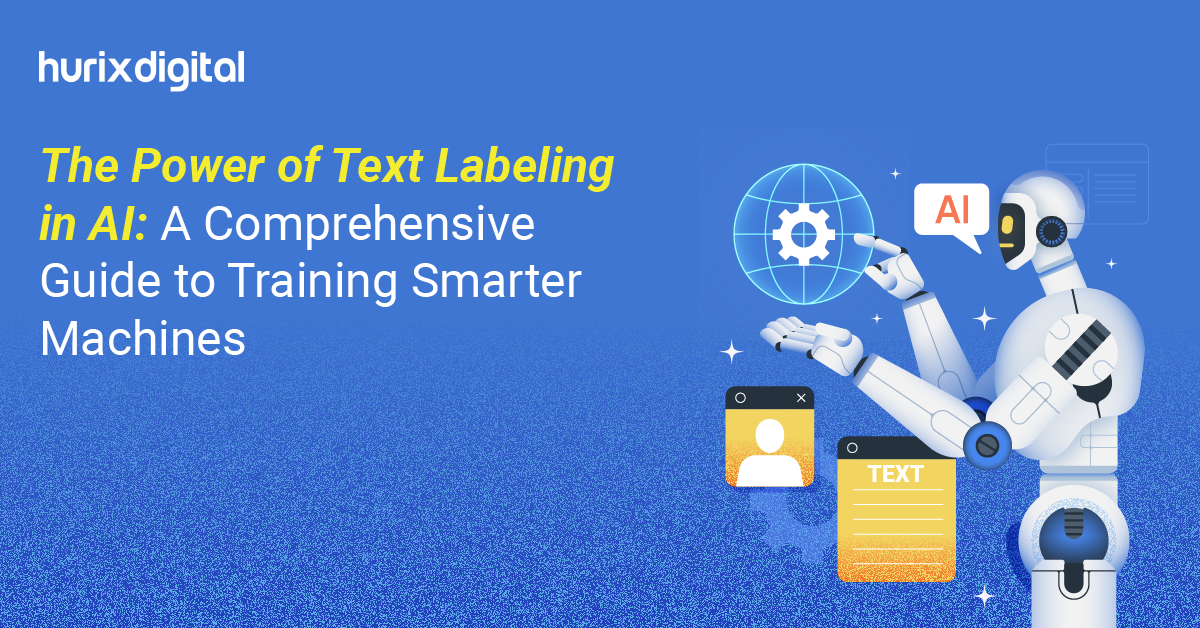
The Power of Text Labeling in AI: A Comprehensive Guide to Training Smarter Machines
Summarize with:
Artificial intelligence (AI) is advancing as machines learn to precisely interpret human language. It can be a virtual assistant booking flights or a chatbot managing customer inquiries. The base of these systems is implanted as one essential operation: text labeling.
For AI models, text labeling plays an important role in enabling the comprehension of human language, especially for those focused on natural language processing (NLP). This procedure allows the machine to extract meaning from raw text, letting it execute tasks like sentiment analysis, topic classification, named entity recognition, etc.
Table of Contents:
- What is Text Labeling?
- Role of Text Labelling in Machine Learning
- Types of Text Labelling
- Challenges in Text Labeling
- Overcoming the Challenges
- Tools for Text Labelling
- Applications of Text Labelling in AI
- Conclusion
What is Text Labeling?
It is concerned with assigning labels to text data, i.e. markers, which provide information regarding text. Labeled data is crucial in machine learning, specifically in supervised learning wherein the AI model gains knowledge from pairs of input data and their matching output labels. Thus, the output for new data can be concluded according to patterns the model learned during the training period.
These labels, in the context of NLP, would contain simple categories such as sentiment to information like named entities or parts of speech.
Example:
“Amazon is opening a new office in New York next month.”
Here:
– “Amazon” could be marked as an Organization.
– “New York” could be marked as a Location.
– “Next month” could be marked as a Date.
These labels explain the individual words of the AI model and their relationships.
Role of Text Labelling in Machine Learning
AI applications, particularly natural language ones, rely on text labeling and human language. Text labeling enables models to learn from labeled examples and make generalizations.
It helps AI learn as follows:
1. Supervised Learning: The models require labeled datasets to learn mapping inputs (text) to outputs (labels). For example, customer reviews classified as neutral, positive, or negative are used to train a sentiment analysis model for recognizing patterns in text correlating with the corresponding sentiment.
2. Increasing Model Precision: The labeled data quality affects the model’s accuracy. While poorly labeled data results in flawed learning, correctly labeled data enables the model to generalize new data accurately.
3. Automation of Tasks in Language: After training, models can automate a wide range of language-related tasks, like classifying emails, interpreting chatbot user intent, extracting data from documents, etc.
Also Read: Your Handbook on Crafting AI-Powered Alt Text with EqualSense
Types of Text Labelling
1. Text Classification Labelling
An easiest and most commonly used text labeling where a predetermined category is allocated to an entire section of text is known as text classification.
– Sentiment Classification: It is used where the text (review or social media post) is classified as positive, negative, or neutral.
Example:
Text: “I love this product!”
Label: Positive
– Spam Detection: In email filtering, text is classified as either spam or not. The labels help the AI model learn which characteristics define spam emails.
– Topic Classification: News articles are labeled with topics like politics, sports, or technology in news categorization.
2. Named Entity Recognition (NER)
NER categorizes named entities in text into different classes, like names of people, organizations, locations, dates, etc.
Example:
Sentence: “Barack Obama was born in Hawaii.”
Labels: Barack Obama (Person), Hawaii (Location)
For information extraction tasks, where the objective is to extract structured data from unstructured text, NER is useful.
3. Part-of-Speech (POS) Tagging
POS tagging allocates grammatical labels to words in a sentence, recognizing their syntactic role. This tagging helps the AI model to grasp the grammatical structure of a sentence, necessary for leading tasks like text generation and translation.
Example:
Sentence: “The quick brown fox jumps over the lazy dog.”
POS Tags: The (Article), quick (Adjective), brown (Adjective), fox (Noun), jumps (Verb), over (Preposition), lazy (Adjective), dog (Noun)
4. Sentiment Labelling
It detects the emotional tone of a part of the text involved in social media monitoring, product reviews, and customer feedback analysis.
Example:
Text: “The customer service was terrible.”
Label: Negative
Sentiment labeling includes nuances, like recognizing emotions.
5. Intent Labelling
Conversational AI, like chatbots, uses intent labeling to comprehend the intent behind a user’s query.
Example:
Query: “Can you book me a flight to New York?”
Label: BookFlight
Here, the AI will be able to understand the user’s intent in the query and can act accordingly.
6. Sequence Labelling
It adds labels to sequences of words in a sentence. NER or POS tagging are some of its uses. It is essential for AI models in language understanding tasks.
Challenges in Text Labeling
Here are some of the most common challenges in text labeling:
1. Time and Cost
Manual labeling of large datasets can be a costly and tedious task. To give labels, human annotators examine a large amount of text data, making it a labor-intensive process.
2. Subjectivity and Ambiguity
Labeling is a tough task as human language is subjective. For example, the exact meaning may vary from the emotion when using sarcasm in text, thus confusing the sentiment classifiers. This is a challenge to human annotators when forming compatible labels.
3. Data Imbalance
An imbalance in labeled data may occur when there are more positive reviews than negative ones in sentiment analysis, resulting in a model biased toward anticipating positive sentiment. This needs accurate sampling to balance the classes.
4. Scalability
The requirement for discrete labeled datasets is increasing with the complexity of AI applications. For tasks like legal document labeling, expanding the labeling process while maintaining accuracy is challenging.
Overcoming the Challenges
Techniques to address these challenges include:
- Semi-Automated Labelling Process: AI models can help human annotators by recommending labels humans can verify and confirm. This expedites the labeling process.
- Active Learning: Here, the model identifies challenging examples and asks human annotators for labels. This enhances the model’s performance while decreasing the amount of manually labeled data.
- Crowdsourcing: Companies can outsource the labeling process to numerous workers through platforms like Amazon Mechanical Turk, which speeds up and lowers costs.
Tools for Text Labelling
- Prodi.gy: This tool creates training data for machine learning models. It helps in tasks like text classification, NER, and POS tagging.
- Labelbox: It involves the labeling of data including different formats, texts, images, and videos.
- Tagtog: This tool is used for labeling NER and document classification tasks.
- Amazon SageMaker Ground Truth: Uses machine learning to provide labeling assistance. A fully managed data labeling service.
Applications of Text Labelling in AI
- Customer Support Chatbots: By identifying users’ purpose and providing relevant information, text labeling helps chatbots understand user queries.
- Sentiment Analysis: To understand public opinion and enhance their services, businesses use sentiment analysis to understand customer feedback, social media mentions, and product reviews.
- Information Retrieval: It is essential in the extraction of valuable content from a large volume of unstructured data of text like the identification of a particular entity in legal documents or some medical notes.
- Content Moderation: For detecting sensitive content on social media, like hate speech or adult content, these sites use labeled datasets.
Also Read: Ready for 2024? The Alt Text Toolkit for Developers and Content Creators
Conclusion
Text labeling helps AI interpret human language, enabling sentiment detection and entity identification, with ongoing tool improvements enhancing accuracy and efficiency.
Ready to harness the power of advanced text labeling for smarter AI? Connect with Hurix Digital today and let our expertise in Annotation Services guide your AI to new heights of precision and performance. Reach out now—let’s make your AI smarter, together!
Connect with us today to learn more about our AI content services.
Summarize with:

Vice President – Content Transformation at HurixDigital, based in Chennai. With nearly 20 years in digital content, he leads large-scale transformation and accessibility initiatives. A frequent presenter (e.g., London Book Fair 2025), Gokulnath drives AI-powered publishing solutions and inclusive content strategies for global clients
 Upcoming Masterclass | Build an Army of Brand Evangelists using Training & Development | November 20th, 8:30 AM PDT | 11:30 AM EDT | 10:00 PM IST
Upcoming Masterclass | Build an Army of Brand Evangelists using Training & Development | November 20th, 8:30 AM PDT | 11:30 AM EDT | 10:00 PM IST




